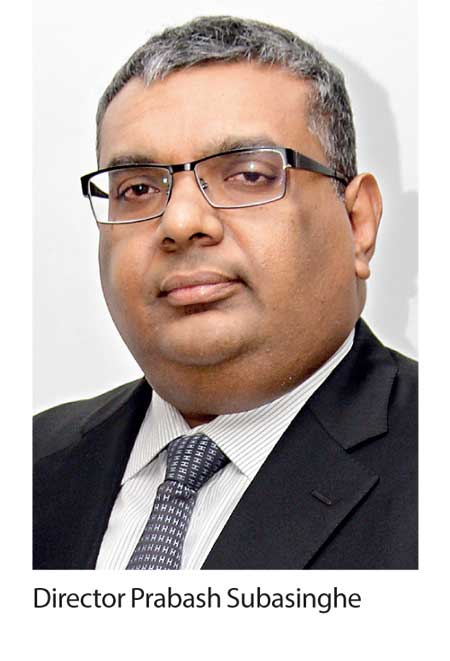Sunday Dec 28, 2025
Sunday Dec 28, 2025
Tuesday, 26 September 2017 00:00 - - {{hitsCtrl.values.hits}}
 Expressing his views on the Sri Lankan MSME sector alongside the reasons for his unwavering confidence in SDB Bank’s growth potential, Non-executive, Non-independent Director, the largest shareholder as at 31 August with 11% stake in SDB, and the Managing Director of prestigious Global Rubber Industries Ltd. Prabhash Subasinghe underscored the fact that the entrepreneurship and microfinance sector has tremendously supported and consolidated the country’s economy.
Expressing his views on the Sri Lankan MSME sector alongside the reasons for his unwavering confidence in SDB Bank’s growth potential, Non-executive, Non-independent Director, the largest shareholder as at 31 August with 11% stake in SDB, and the Managing Director of prestigious Global Rubber Industries Ltd. Prabhash Subasinghe underscored the fact that the entrepreneurship and microfinance sector has tremendously supported and consolidated the country’s economy.
Global Rubber Industries (GRI), predominantly an export company who has a worldwide dealer network with sales and distribution offices in several countries including the USA and Australia, has drawn its attention to Sri Lanka’s SME Sector. “We possess substantial investments in overseas markets, and we are now looking to further invest in Sri Lanka, a country that has clearly shown high growth potential in the SME sector,” Subasinghe stated.
GRI currently holds investments in the financial sector and sizeable investments in the insurance sector; hence the move to further invest in the finance sector, specifically in banking, was a strategic decision. SDB was found to be the textbook candidate for investment, owing to SDB’s support from a large chain of SANASA societies. Moreover, the SANASA Movement has maintained long-standing brand recognition in the country, thereby providing assurance of high growth potential.
GRI, which claims to an insurance portfolio, found SDB Bank as a unique candidate for investment in the financial sector, mainly due to SDB Bank being supported by a massive chain of SANASA societies. SANASA Movement has maintained long standing brand recognition in the country, thereby giving a successful growth potential.
Furthermore, when compared to other financial institutes, SDB has an outreach of 8,000 SANASA societies island-wide while the bank asserts claims to astounding 38,640 shareholders. GRI considered this to be an optimistic factor which will contribute towards the bank’s holistic development. “71% of stakes in the bank are owned by a handful of large investors. The largest stakeholders include the SANASA Movement along with the World Bank’s subsidiary – IFC, SBI-FMO, Dr. Senthilver, FMO and ourselves. Conversely, the SANASA Movement comprising of over 8,000 societies holds 29% of the stake. Once again this proves that SDB is an unrivalled bank, as its large investors not only consolidate the bank’s strength, but also offer a steady growth for small shareholders.”
Expressing his views on SDB’s future growth potential, Subasinghe emphasised that GRI, which is armed with expertise and long-standing experience in the industry, has recognised SDB as a small financial institute with considerable development possibilities. “I joined the bank’s Board of Directors in order to extend my fullest support towards its growth. At present the bank’s biggest milestone is Rs. 1 billion profit target. This will significantly elevate the bank’s position among its competitors in the stock market as well as the banking industry.”
Subasinghe further speculated that SDB has several means of growth, established and strengthened by the equity partnerships attained with globally renowned international firms including IFC, FMO, and SBI-FMO. In addition, SDB is supported by several large investors including the GRI, which holds the power to considerably change the dynamics of the bank, and place it on a direct path to progress.
As an outstanding and exceptional entrepreneur in Asia, Prabash Subasinghe shed light upon the strategic and operational importance of developing SME banks from the grass-root level to international level. “I’m an entrepreneur who started on a green field basis and ultimately made it to the major league. I strongly believe that entrepreneurship is the backbone of a country’s economy. I trust that it’s crucial for a bank to support the growth of SMEs. SDB has already specialised in the micro finance and the SME sectors.”
“Entrepreneurship decides the success of a country and its economy. Organisations are made by those who pursue a vision, those who face risks and those who overcome challenges. Personally, I feel that entrepreneurship is holistically essential for Sri Lanka to grow, and the country needs more entrepreneurs,” Subasinghe declared.
“SDB has operated within a certain frame and model, up until now. However, with international financial bodies and large volumes of foreign direct investment (FDI) flowing in, the bank will undergo a prominent positive change in due course, and we are enthusiastic about this happening. Succeeding the involvement of the SANASA Federation and SANASA Movement, we expect tremendous growth performance from SDB in the years to come. I’m personally prepared to extend my time to aid and support SDB and its valuable stakeholders, towards the accomplishments of this goal.”
Speculating a change in the brand mix of the bank, Subasinghe once again underscored the value added from the international equity partnerships entered with the IFC, FMO and SBI. While expanding the bank’s international recognition, the synergy formed with the global financial firms would pave the way for foreign investors to approach and invest in the bank. These partnerships, especially the ties with the World Bank’s subsidiary – IFC, will prove to stand testimony to SDB Bank’s growth potential and exceptional performance.